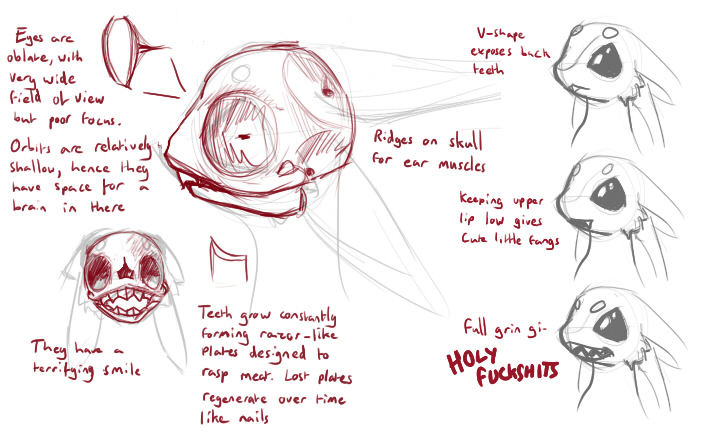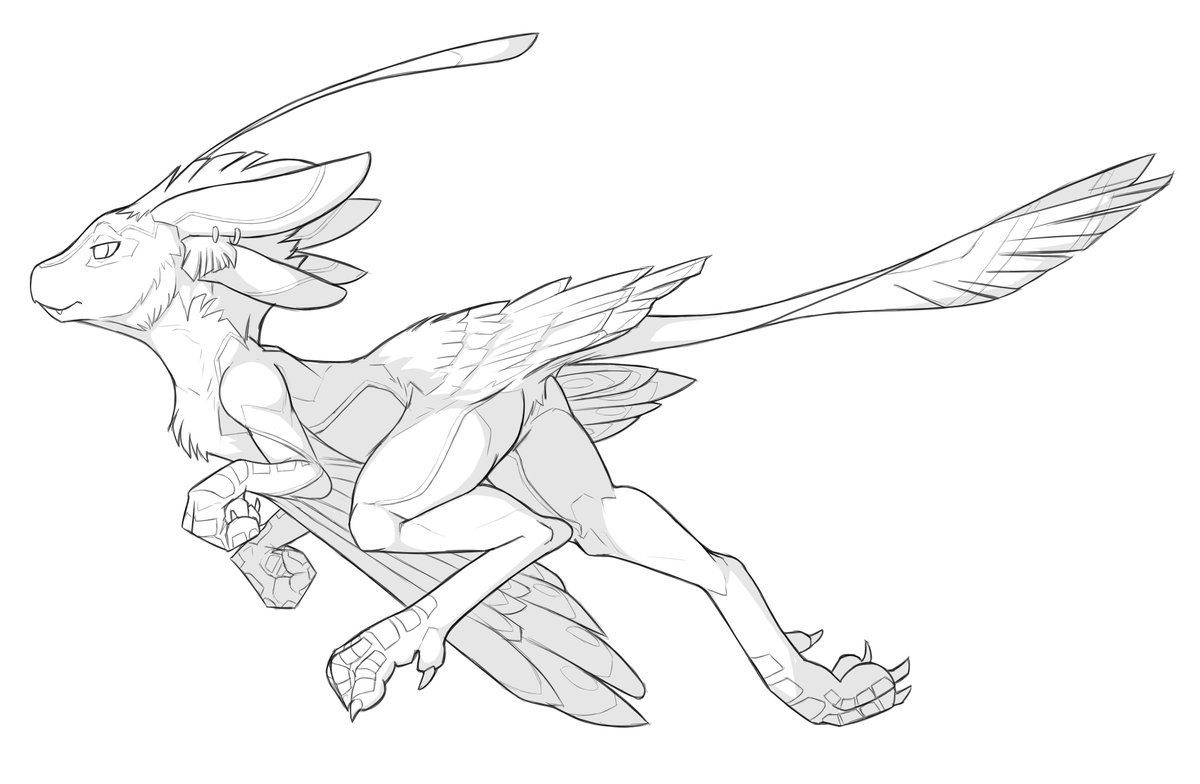Teshari are a sentient, bipedal race of small avians, originating from the Skrell homeworld of Qerr'balak. With very little sexual dimorphism, it can be hard to tell the genders apart. They are naturally able to endure very cold climates and organize themselves in packs. After some initial problems with the Skrell, they came to an agreement and reached for the stars together, thus becoming known with the other races. Teshari are rather fragile when compared to humans and thus are not commonly employed in jobs that involve a risk of injury, like most combat-related jobs. They are naturally rather fast and often try to use their mobility to not get harmed.
Biology
Most Teshari stand between 3’5” and 4’0” tall (~1-1.2 meters), and laid out, 1.5 to 1.8 meters from nose to tail tipand weigh around 30 to 40 lbs. Their body appears to be mostly avian, but with a snout like that found on some reptiles. As such some tend to call them “Feather Raptors”. Teshari are bipedal creatures with digitigrade legs and a long tail which acts as a counterbalance. Compared to humans, they are very fast runners, able to easily jump over benches and tables while at full sprint, but they are rather fragile. While their hollow bones are allowing them to stay lightweight enough to glide on their home planet, they do not allow for a lot of resilience.
Teshari are naturally comfortable with very cold climates. They can survive in temperature ranges between 180K (-93°C, -135°F) and 320K (46°C, 116°F), but will need protective gear outside of that range. They can also comfortably breath and survive out of a pure oxygen bottle set to only 16 kPa, unlike a human who needs a kPa of 21 with a pure oxygen bottle.
Teshari have four big ears, two on each side, and they are known for their very acute hearing. In fact, Teshari can accurately hear people moving on the other side of a wall. They are however not able to hear details, like a whispered conversation or the size of someone moving, any better than humans. However, thanks to their four ears, they can accurately hear if a sound is coming from above or below them. Their hearing is incredibly sensitive and very loud noises, like flashbangs, can more easily stun Teshari and might even cause a loss of hearing.
While Teshari have big, light-sensitive eyes, they are not able to see any better in darkness. Teshari are not blinded by normal lights, they are susceptible to sudden flashes, like that of a flash, laserpointer, or flashbang.
Their ability to glide, their acute hearing, which is also capable of hearing altitude distances, their incredible cold resistance, and their ability to sustain themselves on thinner air, leads to many scientists believing that the first Teshari originated from the mountain ranges in the arctic and tundra areas of their home planet. However, they quickly adapted and spread out into the surrounding areas.
Theshari have two genders, male and female, and reproduce sexually. A Teshari female will lay a single hardshell egg after roughly two months. Some females lay an unfertilized egg every two months, while others only produce an egg after getting fertilized. After a fertilized egg was laid, it takes five more months for the new Teshari to grow and break their shell. Hours after hatching, a Teshari is able to walk.
Sexual dimorphism between male and female Teshari is near-inexistent, making it almost impossible for non-Teshari to tell the difference between them. Especially so because their voices are rather similar. Female Teshari have no breasts or other immediate signs to easily identify them. At the same time, most Teshari don’t seem to differentiate between male and female Teshari when it comes to work and generally any activity other than sex.
Teshari are carnivores, as evidenced by their sharp teeth. They used to hunt game up to their own size, using pack tactics and very early tools and weapons to engage without exposing themselves to danger, using spears and slings in their early stages.
Psychology and Sociology
Most Teshari are organized in packs, and basically their entire social life revolves around and among the pack. It’s important to note that in most packs, family has little meaning. The young are raised by the pack as a whole, the natural parents of a Teshari might hold the position of a “favourite aunt or uncle” though. The raising of a child Teshari is a communal task for the entire pack. Everyone is supposed to watch over the young, play with them, teach them what they need to survive, and similar.
In the eyes of many Teshari, the pack is the most important in their life. They will go out of their way to stick to their pack and strife to improve the situation for all of the pack whenever possible. In the past, those who were not utterly devoted to their pack were seen as weird and mentally ill. The various packs among Teshari are often structured quite differently. While some packs might have one clear leader, others might have a tribunal, or just communaly decide on important topics together. There is no clear trend between the various packs, but in more recent history, as Teshari formed towns and cities, packs became ever larger, sometimes encompassing an entire building block.
Most packs share that there is little privacy. Given the cold climate Teshari originate from, it became common to not have a room with a bed for every person or pair, but instead have large communal sleeping rooms where they cuddle up together to share each other’s warmth. Among many packs this has lead to a very carefree attitude regarding physical contact, like hugging and cuddling, but it also is not uncommon for male and female Teshari to mate in these shared rooms. Similarly, some packs tend to stay monogamous, but many packs are polyamorous.
In their past, Teshari tribes often felt a very strong urge to protect each other. While useful in the past to make sure that a single Teshari would still be cared for when hurt or sick, this has caused some problems in the more enlightened times, with Teshari packmates forming up to try and help another packmate, even if that one has committed a crime and is being locked up by the police or various station security. This has lead to some problems, but both Teshari and Skrell soon learned that it’s best to get the pack involved in the prosecution so the pack as a whole agrees that the single packmember has done something wrong, rather than trying to keep them away from all trials and not inform them.
History
In their beginnings, Teshari spread from the mountain ranges in the cold climates and into the tundra and arctic regions of Qerr'balak. They hunted small game and used pack tactics to help each other and survive, often living in caves and later on in makeshift buildings made of snow, ice, and whatever they had available. Because of the cold weather, farming was barely ever possible, but the first permanent settlements formed at shoreline locations, allowing for fishing and thus a more permanent food source. But because wood is scarce in the tundra, only small ships could be built.
First contact with the Skrell, of the Vikaran Federation, happened during early expansion towards the warmer regions. And while these regions provided more game to hunt and wood to cut, they were also warmer than most Teshari comfortably wanted to handle. And when they met the first Skrell, many Teshari were more than happy to stick to the colder, more comfortable areas.
Over the centuries, Teshari and Skrell had some positive and negative run-ins with each other. There were some border conflicts, but neither species tried to go into an all-out war with each other. Instead, they kept an uneasy co-existence since neither had too much interest in the other’s territory. Instead they engaged in trading, which gave the Teshari access to more wood while Teshari exported craftmanwork and minerals mined from the mountains.
As technology advanced and the planet became more and more globalized, many Teshari started to live among bigger cities. Packs tended to stick together even when moving to the bigger cities. During this technological revolution, many Teshari proved to be valuable when working in fields that require little physical strength. Some Teshari still wanted to be police officers or soldiers, but often they had to admit defeat when they saw themselves physically outclassed. But as the centuries passed, technological solutions for their problems could be found, starting with powered tools and firearms, and going on to bigger technological wonders, like vehicles. In fact, many Teshari are naturally adept at piloting, given their history of being mountain gliders.
Together with the Skrell, they explored their own solar system and then the stars around them, founding many colonies, often besides those of the Skrell, and often with them as well. But it were the Skrell who made first contact with other races in the galaxy, and the Teshari had no say in being brought along to the ensuing diplomatic missions.
Not everything went well, some hiccups happened along the way. Namely, when the Skrell first took a Teshari Diplomat with them to introduce them to the other races, one of the ambassadors assumed that the Teshari was a pet brought along. A Teshari delegation was once sent to meet the Clown Planet. The so-called “Rubber Chicken Incident” is the resulting incident, where no information seemingly exists beyond heavily redacted incident reports. In fact, all most would know of the incident is the name itself.
On some planets and colonies, Teshari were sometimes almost, and sometimes actually attacked by the local colonists who assumed that they were some sort of hostile alien. Some people started to jokingly call Teshari chickens, and some species started to joke about them probably tasting like chicken, which lead to some of the harsher communities out there, like Vox Pirates and Unathi militants, to actually test this theory. A very controversial book by the Vox Marauder Yacharaka, called “23 Kind of Teshari Dinner” was published, and were it not for the almost-immediate ban of this book which glorified murder, no one would have read it. It's immediate ban triggered an almost immediate underground following, and copies are still available on isolated exonet servers.
But in the end, no species has an easy beginning when meeting the other spacefaring races and becoming part of the galaxy as a whole. And with that in mind, it is remarkable that the Teshari have managed to bounce back from such a first impression.
Today, Teshari often work in professions where intelligence and wits are needed more than muscle strength, but with modern tools there are still Teshari Miners and Security Officers.
Technology and Popular Media
Teshari and Technology
Thanks to the influence of the Vikaran Federation on their homeworld, Teshari have grown up used to seeing other technology, and adapting it for themselves. What started with wooden constructions, given that they themselves didn’t have much wood to learn with, continued with other technology down the centuries. Teshari became adept at using other technology and adapting it to their needs. At the same time, they kept working on new technologies as well, to not fully depend on others.
When it comes to using the technology of other species, the Teshari's small size becomes a disadvantage. By now, it is commonly known that most Teshari have difficulty wielding especially large tools or weapons, and most tools have to be specially modified, or designed, to accommodate the Teshari's small stature. Living quarters on space stations or surface colonies also have to adapt to Teshari inhabitants, though this usually amounts to colder living quarters and copious amounts of step-ladders.
Teshari in Popular Culture
With their relatively recent addition to the galaxy as a whole, Teshari have seen an uprising in media attention. While rarely portrayed in the role of the solitary hero, they are often found as sidekicks, fitting that role thanks to their strong pack structure and serving as loyal helpers. They are also often seen in roles that require wits, like in “Ocean’s 34” where a Teshari serves as the teams hacker during a heist.
In stark contrast is the movie “Cold Blood”, which focuses on Teshari's speed and ability to survive in cold environments. In this horror movie, where a team of mercenaries come to the aid of colonists on an arctic world, Teshari are portrayed as cruel and efficient hunters, striking when they deem it right and thus strike fear into the colonists. During the course of the movie, one after the other of the mercenaries gets dragged off into the cold arctic and is presumed dead, until in a big twist it is revealed that the Teshari kidnapped them to ask for their help against the colonists, who destroyed their settlements.
Author: C0rtana (Alina)
Galactic Species
| |
| Common Species | Humans, Synthetics, Skrell, Tajara, Teshari, Unathi |
| Uncommon Species | Akula, Alraune, Auril, Dremachir, Naramadi, Zaddat, Dnin-Nepids |
| Whitelisted Species | Adherent, Dionea, Phoronids, Proteans, Shadekin, Vox, Xenochimera, Xenohybrids |
| Misc Species & Data | Minor Races, Scori, Changelings |



